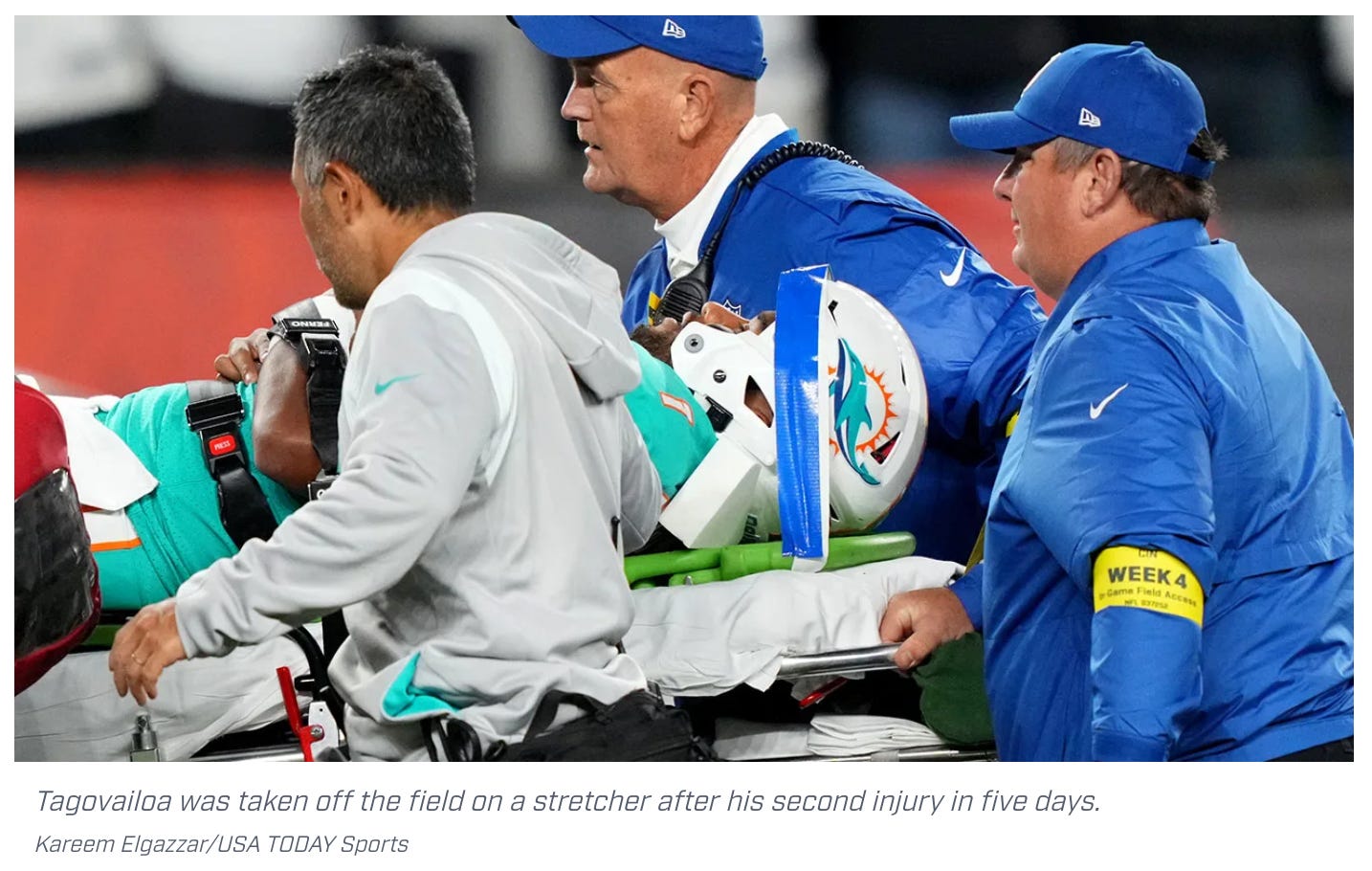The Human Brain Can Only Take So Much Punishment
And football pushes the average player's brain far beyond that point
Every fall about this time I experience the same mixed emotions. Do I continue to love the NFL and college football the way I always have? Or do I finally admit that the damage it does to those who play the game is simply too much and too brutal?
I say this as someone with my own history of traumatic brain injuries. Over the course of six months during my last season as a goalkeeper on an amateur team in St. Paul, MN, and my college soccer team, I suffered seven concussions. Those are the ones I recall; it’s possible there may have been more. This was back in 1981 when it was still called “getting your bell rung.” No one gave much thought to the long-term effects of repeated concussions, and I’m pretty certain I played numerous games when I was still feeling the effects of a concussion.
There was no one to hold me back, and the science surrounding concussions was almost nonexistent four decades ago. I’d take a blow to my head and lose consciousness. Then I’d wake up on the sideline, shake my head a few times, and go back into the game. Sure, I might have had a headache, I may felt nauseous, and perhaps even been disoriented and light-headed, but I’d just “gotten my bell rung.”
Four decades later, I know in retrospect that handling things the way I did was pretty stupid. But the truth was that the coaching or medical staff (such as it was at the time) nor I knew anything about concussions. I’ve had a long history of migraines and Attention Deficit Disorder (ADD), and those things may or may not be related to my repeated concussions. There’s no way to know conclusively.
What concerns me about college and professional football is the sheer violence of the game. I once met a former NFL player who described the game as being like an automobile accident on every play. If you’ve ever experienced the impact of an auto accident, then you have some idea of what he was referring to. Now imagine that sort of impact 30, 40, perhaps 60 or more plays per game over a 17-game season and, say, a five-year career. That’s an astonishing amount of violence done to the human body.
And that makes what happened to Miami Dolphins quarterback Tua Tagovailoa so concerning.
MIAMI -- Speaking Wednesday for the first time since sustaining a concussion on Sept. 29, Miami Dolphins quarterback Tua Tagovailoa said he remembers most of that night but lost consciousness after a hit that sent him to a hospital.
He was concussed in Miami's loss to the Cincinnati Bengals in Week 4 when he hit his head on the ground while trying to extend a play, and was briefly hospitalized before being discharged and returning to Florida with the team after the game.
Tagovailoa said he doesn't remember what happened immediately after hitting his head on the ground and losing consciousness but does remember being driven to the University of Cincinnati Medical Center via ambulance, as well as his trip back to Miami with his teammates early the next morning.
There’s a longer video with an explanation from a concussion expert about how hits like this can damage the brain (The NFL has blocked the ability to embed their content), but the short version is also pretty scary.
For someone like myself with such a robust history of traumatic brain injuries (TBI), watching Tagovailoa lose consciousness was especially terrifying. His body was spun around and his head slammed into the turf at an alarming rate of speed by a very large and strong defensive lineman. If you watch Tagovailoa’s hands and the way his fingers curl, it was a terrifying indication of a very serious TBI.
On Thursday night, the football-watching public saw a human being get thrown to the ground at a speed so great it caused his neck to jerk backward like a broken Pez dispenser.
Upon impact, the person could be seen slowly rolling over onto his back and looking at his fingers, which were splayed in myriad directions. The person was taken away on a stretcher and rushed to a nearby hospital.
Four days earlier that same person was shoved following a jumping movement while throwing a ball and slamming his head against the ground. He was barely able to return to his feet, which meant that the impact of the shove occurred when he was in a vulnerable position, unable to brace his body for a rapid free-fall to the ground. Upon standing up, he made it eight steps before stumbling and falling to one knee. He told everyone he had a back injury and was cleared to move on with his day.
Except it was nowhere near that simple. It wasn’t simply a back injury. Yes, he may have hurt his back on the play, but that wasn’t the matter of greatest concern. Four days before the Thursday night game against Cincinnati, Tagovailoa’s head was slammed against the turf. He was wobbly and unable to brace himself as he fell to the ground after taking a few steps- one of the classic signs of a TBI.
Yet he told everyone he had a back injury and was soon cleared to return to the game when he had no business being back between the lines.
Even with the NFL’s expanded concussion protocols, which are designed to prevent this sort of abuse, Tagovailoa was allowed to return to the game despite displaying clear signs of a TBI. Four days later, the damage was made worse when his head was slammed into the turf again.
Of course, Tua Tagovailoa isn’t the only player risking the health of their brain and their future by playing football. It’s a dangerous game played by large, strong men crashing into one another with breathtaking force and violence. While the science of helmets and padding has improved exponentially over the years, there’s little that can be done to protect players against the sheer force and violence of the game.
The human body was not designed to play football. This is especially true when one considers the size, speed, and strength of today’s players.
Yet the NFL owns Sundays and millions of boys grow up dreaming of playing in the NFL, and millions more Americans are devoted die-hard fans. I’m one of them; I’ve been a Minnesota Vikings fan since I was old enough to know what a football was.
But that love comes with mixed emotions. Is that love worth the battered bodies, the damaged brains, and the shortened life spans that await some players once their (the average NFL career is <4 years) playing days are over?







"NFL player who described the game as being like an automobile accident on every play."
That's a pretty vivid image for me. I was #3 in a 6 car accident, meaning there was one car between myself and the Ford Explorer that slammed into a stopped line of traffic at 45MPH. The I-beam of my convertible was visibly scissored. I didn't realize it at the time, but even with the airbag, I was slammed into my shoulder harness so hard that I cracked a rib.
You've described your head injuries before, and every time it makes me wince.
Thanks for sharing this.